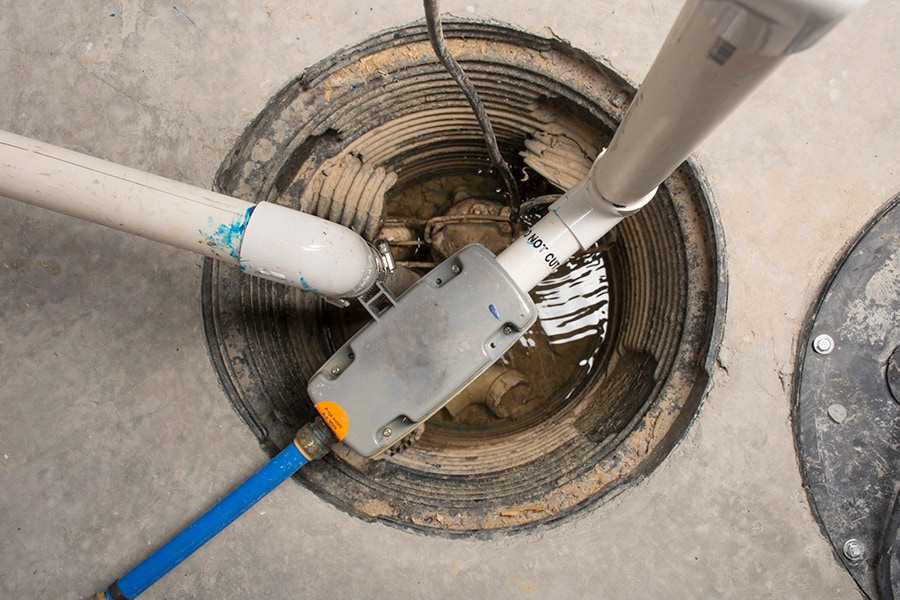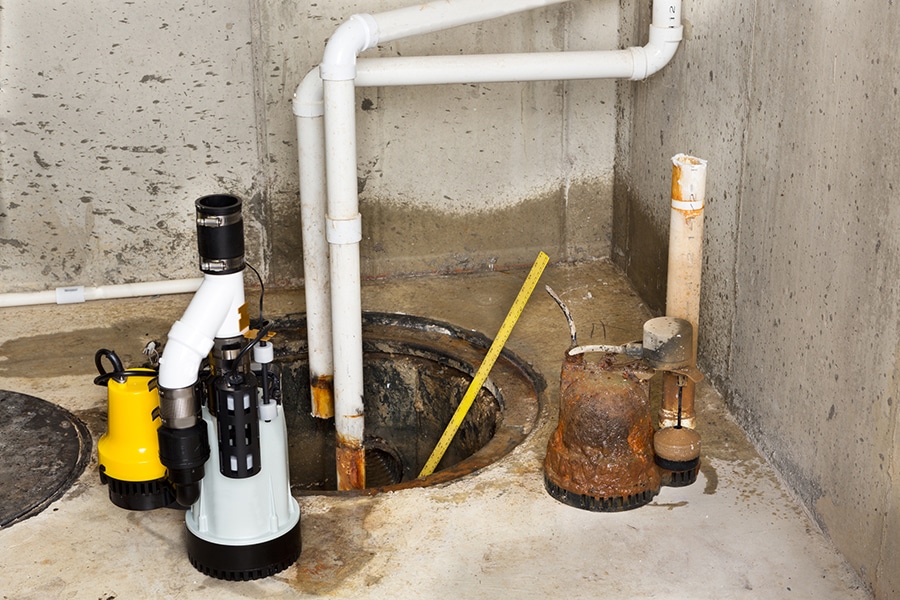Many homes have sump pumps in the basement or crawl space. Sump pumps help keep your home free from excess water. You may not even know your home has a sump pump, especially if you live in an area with little to no excess groundwater.
Sump pumps are a part of your home’s water management system. Routine sump pump maintenance is critical to help keep your pump running smoothly and efficiently.
What is a sump pump, and what does it do?
A sump pump removes excess water from your home. You’ll typically find it in the lowest part of a residence, in a basement or crawl space. They use electricity and plug into an outlet or connect to your electrical grid to work.
Sump pumps are built inside a sump pit or sump basin. The pit collects excess water or rainfall during a flood or burst pipe.
If there’s a lot of water, the basin fills up and the sump pump automatically turns on and removes the water through external drainpipes. It’s normal for a sump pit to always have some water inside and for the sump pump to be submerged.


What are some common sump pump problems and solutions?
Do you know what the signs of a malfunctioning sump pump are? Your sump pump may require general maintenance to function correctly, like other home appliances.
Here are a few common sump pump problems and what you can do to prevent or fix them.
- Unusual or foul odors
- Dirt and debris can accumulate
- A faulty or damaged float switch
- Clogs
- Unusual noise or vibrating
- Oil leaks around the hosing
- The sump pump is the wrong size
Unusual or Foul Odors
Your sump pump shouldn’t smell bad. There could be issues with stagnant water, a dry sump pump basin or improper drainage that can make the pit smell bad.
There are a few reasons that may cause the sump pump or pit to smell:
- The sump basin may be dried out. Your sump pump should always have some water, but sometimes you may experience dry periods that cause all the water in the basin to dry out. Escaped gases from an overly dry pit can cause unpleasant odors.
- Water can become stagnant inside the sump pit. If water doesn’t activate the sump pump, groundwater can accumulate and stagnate, causing a moldy smell.
- A faulty float switch may keep trapping water in the basin instead of removing it, leading to water stagnation.
- A defective check valve can also lead to stagnant water. When this happens, water that was supposed to be removed from the basin may flow back in.
How can you remove sump pump odors?
You should ensure that your sump pump always has a little water inside the basin to prevent it from drying out.
Add enough water to cover the drainage pipes and lines to keep odors at bay and your sump pump adequately maintained.
To prevent or fix stale odors, you can disinfect the sump pit with a bleach solution using one cup of bleach for every gallon of water.
1. Pour enough water into the pump to engage the float switch to turn on the pump.
2. Add the bleach into the sump basin.
3. Scrub the sides of the pit to clean any residue or grime and let the pump run.
A professional plumber can check if your sump pump is malfunctioning or make any other necessary repairs.
Dirt and debris can accumulate
As your pump fills up, dirt and debris may clog electrical components or fill the pipes or drain lines with sediment. A clog like this could also cause the motor to burn out.
A faulty or damaged float switch
The float switch turns your pump on or off. If something damages the switch, the sump pump might never activate. This could cause costly water damages.
There’s also the possibility that your switch isn’t damaged, but that is might be jammed or filled with dirt, causing the sump pump to malfunction.
Clogs
Clogs are a common cause of sump pump failure, especially if you have a lidless model. A clog may be the culprit if the pump is running but not removing water from the sump pit.
How can you fix a sump pump clog?
Regular maintenance is key to preventing clogs. But if the pump often clogs, here is a step-by-step guide to fixing this issue:
1. Turn off the breaker to your sump pump, so it’s not receiving electricity.
2. Disengage the pump from its wires and remove it from the pit.
3. You should place it on a towel or other absorbent material to catch any water.
4. Check the discharge lines and remove debris, like rocks or other items the water might have carried into the pit.
5. Remove any sediment you find in the pipe’s entrance.
6. Re-attach the sump pump and place it back into the hole.
7. Switch the breaker back on.
8. Activate the sump pump float switch by adding water into the basin.
9. Check to see that your lines are draining correctly and that water is coming out where it’s supposed to.
10. If your pipes still seem clogged, finer sand or build-up deeper inside the lines may require professional cleaning or plumbing service.
If your sump pump has a lid, you should always make sure that it’s tightly sealed to prevent dirt and debris from clogging the machine.
Unusual noises or vibrating
It’s perfectly normal to hear a low-level hum, but if that hum increases in frequency or the humming is in combination with the pump not properly pumping water, you may have a problem with parts wearing out.
Some noises to look out for include grinding, excessive rattling or banging around.
What can you do if you hear weird noises?
You should check that the vent hole isn’t clogged. Other culprits can include a jammed check valve, stuck or damaged impeller or an overworked motor. The impeller can become dented or bent when rocks or wood are drawn into the sump pump, so you should check these components when you do your regular maintenance.
You should also check that the discharge pipes aren’t frozen. If that is the case, you can carefully heat the area with a small space heater to melt the ice.
Oil leaks around the housing
Oil leaks can occur in different sump pump models.
If you have a pedestal sump pump, you can see if there’s an oil leak by inspecting the housing visually or by touching the seams. You should mount these sump pumps vertically, so it will be easier to diagnose an oil spill.
Submersible sump pumps are more difficult to check for an oil spill. If the housing leaks, the oil should float to the top of the water. You won’t know if that spill is for something else in your basement until you take it apart.
How can you repair an oil leak?
Leaking oil may point to a defective gasket or housing damage, so you may have to purchase new parts. If this doesn’t work, however, you should consult a professional.
The sump pump is the wrong size
Sump pump sizing may not seem like a big deal, but an incorrectly sized pump won’t be able to function correctly and can lead to an overworked motor. A pump that is too small won’t be able to remove water, which could lead to basement flooding. And if your pump is too big, it may get overworked and burn out.
If you’ve found that your pump is continuously running, it may signify that it isn’t the correct size. When replacing an old pump, you should get a similarly sized model to replace it.
Why does your sump pump keep turning on and off?
If you’re experiencing more rainfall than usual or live in an area that gets a lot of rainstorms, it’s normal for your sump pump to cycle on and off.
If it’s continuously turning on and off and there isn’t a clear weather-related reason, there may be underlying issues with your pump or float switch.
- The float switch may be broken or stuck “on.”
- The check valve may be damaged.
- A clog or break in the drainpipe may cause the sump pump to cycle on and off frequently.


Sump pump maintenance and repair tips
Maintaining your sump pump is key to keeping it functioning correctly. You should check that it’s working at least once a year, though we recommend checking it more often during the rainy season or when the snow melts.
Since your sump pump plugs into an electrical outlet and, ultimately, your home’s power grid, you should always make sure the breaker for the sump pump hasn’t turned off after a power outage. Consider checking the electrical connection and circuit breaker as a part of your regular sump pump maintenance.
If you ever need to repair your sump pump, make sure you’ve turned the breaker off to disconnect it from electricity.
To check that your sump pump is pumping water, you can do a water test. Once you locate your pump, add water into the sump pit until the pump is activated. Make sure water is pumping out.
How often should I clean my sump pump?
Periodic cleaning helps prevent odors and sediment accumulation. It’s best to clean your sump pump every 3 to 6 months or more frequently if you live in an area that experiences heavy rain or snow.
Don’t forget that your sump pump connects to an electrical outlet. You should always turn the breaker off before removing the pump for maintenance.
Monthly:
- If your pump removes washing machine water, it’s best to clean it every month to keep it functioning correctly. Clean the pump screen or inlet opening, if needed.
Quarterly:
- Unplug and remove the sump pump and ensure the inlet screen is free from debris. Remove any standing water from the basin and re-fill it with enough fresh water to cover the drainage pipes before re-installing the sump pump.
- Test that the float switch is working by adding water into the pit until it pumps.
Annually:
- You should do a deep clean of your sump pump and pit every year. Remove the sump pump, clean any debris in the basin, then scrub the pit.
- Test that the float switch and drainage pipes are working properly by pouring enough water to activate the switch. Then, check that the pipes are correctly discharging the water.
- Don’t forget to plug it in and turn the breaker back on once you’ve cleaned the sump pump and pit.
Can a sump pump run without water?
Water should always submerge your sump pump. If this is not the case, it can overheat, burn the motor out or damage parts of the machine.
Can a sump pump run without electricity?
Sump pumps run on electricity, so if it gets unplugged or short circuits, the pump stops moving water out. If water is still filling up the pit, it could back up into your home and cause flood damage.
How to avoid this problem: Check that the sump pump is plugged in and that the circuit breaker is still good, especially during rainstorms. It’s also a good idea for you to add flood leak detectors in the basement, so you’ll know if the pump has stopped functioning.


What are the signs that you need to replace your sump pump?
Your sump pump is old.
A sump pump may last 5 to 10 years, depending on where you live and how hard the pump has to work. If you live somewhere it often rains, it may need to be replaced every 5 to 7 years, versus a pump that only runs a few times a year, which may need to be replaced every 7 to 10 years. Yearly inspections will make it easy to know when the sump pump has come to the end of its life.
Your sump pump is rusting.
If your sump pump is a model that has constant water exposure, it may rust.
Rusting may signify that your sump pump is an older model made before rust-resistant materials became common. Rusted battery terminals may lead to future drainage problems.
If you can’t remove the rust by cleaning it, you may need to buy a new part or even an entirely new pump.
If there is water in your basement, it’s time to replace your sump pump.
There are many reasons your pump could stop working, but if it’s not doing its job of pumping water out, that’s a telltale sign it may need a repair or replacement.
ADT water leak detectors can help notify you of any possible flooding.
Monitored flood detection sensors can help give you peace of mind with an alert sent to your phone from virtually anywhere you are.
Flood sensors are just one part of a home security system. Add window and door sensors, cameras and CO and fire alarms to your home to experience smarter home security.
Call ADT today to help monitor your home against floods, intruders and more.
Frequently Asked Questions About Sump Pump Maintenance
Where is your sump pump located?
You can typically find a sump pump in the lowest part of your home: the basement or crawl space.
Does a sump pump need to be plugged in all the time?
Yes, a sump pump plugs into an electrical outlet to work properly.
How many years does a sump pump last?
A sump pump may last between 5 to 10 years, depending on whether you do regular maintenance and how often the pump runs. In an area where rain or flooding is common, you may need to replace the pump after 5 to 7 years.
Related Articles:


